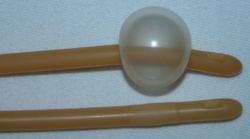Catheter
In the S&M scene, catheters usually refer to urinary catheters, flexible rubber tubes passed up through the male or female urethra into the bladder to permit the drainage of urine as part of medical play or watersports. In medical practice, the term catheter is used in a wider sense to mean any tube allowing access to a body cavity, blood vessel or organ, but these uses are way beyond what should be attempted by the unqualified individual outside of a hospital. Urinary catheterisation itself is not without risk and should not be attempted without suitable training.
Urinary catheters are available from medical stockists and some fetish outlets in a variety of sizes and types, as well as male and female types, the later being shorter to allow for the shorter female urethra. The easiest size to use when starting out is 14 french (a measure of tube gauge) as thinner catheters are rather floppy and difficult to handle, and thicker ones harder to pass. Catheterisation involves gentle passage of the tube up the urethra after lubrication of the urethra and catheter tip with about 5-6mls of sterile water-based lubricant containing 2% lignocaine (a local anaesthetic, available from most chemists). The catheter should never be touched directly, but rather fed out of its sterile bag and into the urethra after cleaning the penis/vulva with a medical disinfectant such as dilute chlorhexidine. Sterile technique is important throughout to minimise the risk of infection. Catheters are available with and without balloon tips, which are inflated through a valve with 5 or 10 mls of sterile saline once the tip is within the bladder. This prevents the catheter slipping back out. The balloon is deflated by re-attaching the filling syringe prior to removal. You will know you have reached the bladder when urine starts to flow out of the catheter. The balloon can then be inflated and a leg-bag or other suitable urine collection receptacle connected. In males some resistance may be met as the catheter passes through the prostate gland. If this is severe or painful, particularly in those over 50 who may have enlarged prostates, do NOT force it.
So why do it? For some, catheterisation is a turn-on due to the loss of control of urination, which may be a form of erotic surrender or humiliation, while others enjoy the sensations it produces. It often forms a part of more advanced watersports scenarios. Most do not find it painful; the sensations are more often described as weird, in a good way! Electro stimulation catheters do not pass urine, but allow for intensely pleasurable rhythmic stimulation of the urethra.
Before attempting catheterisation you will need a sound knowledge of anatomy so you know exactly where you are passing the catheter, what you may come up against, how to get past obstructions, when not to try to get past obstructions and what to do if your victim/patient starts to squirm or complain of pain. You will also need to ensure appropriate sterile technique to prevent the very real risk of infection, and consider responsible disposal of your used equipment afterwards. As you can see, this is not something to be attempted lightly and can only really be taught one to one. NEVER insert any sharp objects into the urethra and never use rigid urethral toys without first having received instruction in their safe use. This article is for information only and does not constitute tuition in these techniques. No responsibility is taken by Wipipedia, LFS or the author for any loss, harm or damage you may come to by attempting any medical play without appropriate tuition.
